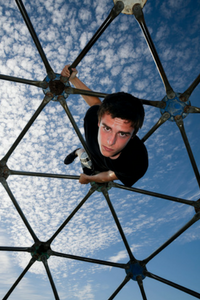 In 1975 Buckminster Fuller coined the term “tensegrity” by contacting two terms — tensional and integrity. Simply defined, tensegrity refers to “compression elements in a sea of tension.”
In 1975 Buckminster Fuller coined the term “tensegrity” by contacting two terms — tensional and integrity. Simply defined, tensegrity refers to “compression elements in a sea of tension.”
“Tensegrity structures,” cantilevered struts held together by strings, appear in photographic records of sculptures created by Rudolf Laban during his convalescence at Dartington Hall (1938-39). Of course, Laban was modeling Choreutic trace-forms. But he seems to have happened upon the concept of tensegrity, or more accurately, to have grasped intuitively today’s emerging models of the body as a biotensegrity structure.
In this biotensegrity model, central to what is now called “spatial medicine,” our bones (typically viewed as compression elements) float in a sea of tension provided by the fascial network, muscles, tendons, and ligaments. Our bodies move and retain their shape through this interconnected network of compression and tension elements. As Deane Juhan notes, “We will be closer to the complex truth in our conceptualization of muscular activity if we regard the body as having only one muscle, whose millions of fibre-like cells are distributed throughout the fascial network and are oriented innumerable directions, creating innumerable lines of pull.”
Laban’s concept of “spatial tension” takes on new resonance when viewed from this perspective. In the “first fact of space-movement” in Choreutics, Laban affirms that “Innumerable directions radiate from the centre of our body and its kinesphere into infinite space.” Among these many lines of pull, Laban goes on to identify two main types, counter-tensions and chordic tensions. The first is simply a kind of reflective body symmetry in which one limb reaches in one direction while another opposes this reach by extending in the opposite direction. Chordic tensions accompany plastic poses and movements in which three or more “spatial/tension paths radiate in space simultaneously.”
Challenge your biotensegrity in the forthcoming “Advanced Space Harmony Workshop,” December 3-4, in New York City.
